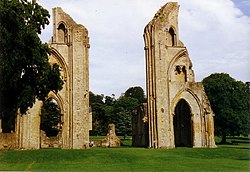Glastonbury Abbey

|
|
| Monastery information | |
|---|---|
| Order | Benedictine |
| Established | 712 |
| Disestablished | 1539 |
| People | |
| Founder(s) | King Ine of Wessex |
| Important associated figures | Saint Dunstan, Henry of Blois, Henry de Sully, Savaric FitzGeldewin, Richard Whiting |
| Site | |
| Location | Glastonbury, Somerset, England |
| Coordinates | 51°8′44″N 2°42′52″W / 51.14556°N 2.71444°WCoordinates: 51°8′44″N 2°42′52″W / 51.14556°N 2.71444°W |
Glastonbury Abbey was a monastery in Glastonbury, Somerset, England. Its ruins, a grade I listed building and scheduled ancient monument, are open as a visitor attraction.
The abbey was founded in the 7th century and enlarged in the 10th. It was destroyed by a major fire in 1184, but subsequently rebuilt and by the 14th century was one of the richest and most powerful monasteries in England. The abbey controlled large tracts of the surrounding land and was instrumental in major drainage projects on the Somerset Levels. The abbey was suppressed during the Dissolution of the Monasteries under King Henry VIII of England. The last abbot, Richard Whiting (Whyting), was hanged, drawn and quartered as a traitor on Glastonbury Tor in 1539.
From at least the 12th century the Glastonbury area has been associated with the legend of King Arthur, a connection promoted by medieval monks who asserted that Glastonbury was Avalon. Christian legends have claimed that the abbey was founded by Joseph of Arimathea in the 1st century.
Suggestions that Glastonbury may have been a site of religious importance in Celtic or pre-Celtic times are considered dubious by the historian Ronald Hutton, but archaeological investigations by the University of Reading have demonstrated Roman and Saxon occupation of the site. In 1955 Ralegh Radford's excavations uncovered Romano-British pottery at the west end of the cloister. The abbey was founded by Britons and dates at least to the early-7th century. Dark Age occupation of the site is evidenced by pieces of ceramic wine jars that were imported from the Mediterranean. A medieval Christian legend claimed that the abbey was founded by Joseph of Arimathea in the 1st century. This fanciful legend is intimately tied to Robert de Boron's version of the Holy Grail story and Glastonbury's connection with King Arthur from the early-12th century.
...
Wikipedia

